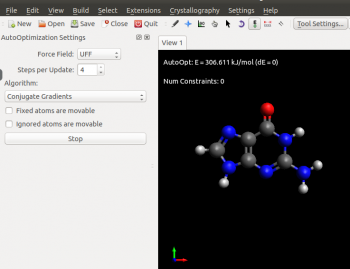Difference between revisions of "Solution LAB2 guanine"
(→Step 2) |
(→Step 1) |
||
| Line 20: | Line 20: | ||
The result of your FF optimisation should look like the following | The result of your FF optimisation should look like the following | ||
| + | |||
| + | [[File:Snapshot avogadro.png|none|350px|top|]] | ||
==Step 2== | ==Step 2== | ||
Revision as of 20:38, 18 March 2021
- Back to the previous page: Electronic properties of isolated molecules#Exercise1
Step 1
- Once you have Avogadro installed, open it and let's use the molecular builder to visualise a Guanine molecule:
Build --> Insert-->Fragment-->nucleobases-->guanine
Click on the selection settings "arrow" and right click to visualise the molecule.
Clicking on manipulate settings "hand" you can then rotate the molecule.
- Now we perform a classical relaxation using an Avogadro built-in Force Filed
Extension-->Molecular Mechanics and we choose a FF Extension-->Optimize geometry
In few steps we have our relaxed geometry that we can save in .xyz format using:
File-->Save as-->select .xyz format and save in your disk as guanine_FF.xyz
The result of your FF optimisation should look like the following
Step 2
Now we are ready to perform a QM relaxation. As a first step, update your pseudo potentials directory by using git commands:
git pull
new pseudo potentials (Nitrogen and Oxygen) will be downloaded in your pseudo potential directory.
Create a relax input file (guanine_relax.in) paying attention to:
forc_conv_thr = 1.0d-3 #we set a low threshold in order to not have a too long calculation ibrav=8 #orthorombic cell with vacuum celldm(1) = 25.00 celldm(2) = 1.0 celldm(3) = 0.8
Set the correct number and types of atoms. Set all the atomic species using the psuedo you have downloaded:
H 1.0 H.pz-vbc.UPF C 1.0 C.pz-vbc.UPF N 1.0 N.pz-vbc.UPF O 1.0 O.pz-mt.UPF
insert the atomic positions in Angstrom:
ATOMIC_POSITIONS (angstrom)
Important: How many k-points you need?
Run the relaxation, it will take a while to rearrange the atoms in the relaxed positions according to the threshold parameter.
$> pw.x < guanine_relax.in > guanine_relax.out &
One the job has converged you can compare the initial position (Force Field relaxed) with the final ones (QM relaxed). You can use xcrysden to visualise the optimisation steps.
xcrysden --pwo guanine_relax.out
you can reduce the dimensionality to 0D and choose the option: Display All Coordinates as Animation In this way you will have a movie of the molecule relaxation
